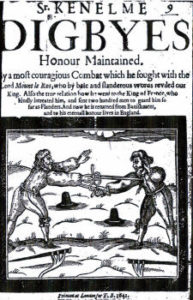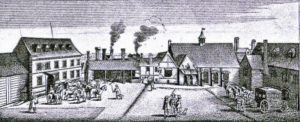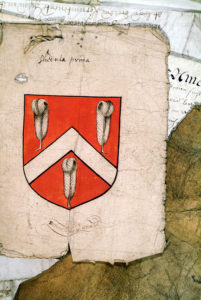
In spite of the crown’s efforts to curb the practice, gentlemen continued to boast of their prowess in duelling : Sir Kenelme Digbyes Honour Maintained (1641) (By permission of the British Library)
This post has kindly been written by Professor Richard Cust from the Centre for Reformation and Early Modern Studies at the University of Birmingham. The Court of Chivalry 1634-1640 is now freely available on British History Online.
Cheating at cards is nothing new. On February 9th 1640, William, Viscount Monson, caught Robert Welch, esquire, trying to shortchange him during a game of piquet at Welch’s house in St Martin’s Lane, London. Welch had palmed two of the cards and then tried to discard them when Monson was not looking. When Monson challenged him, Welch lost his temper saying, ‘I will baffle you just as you have been baffled by every boy in the town.’ He was using the term ‘baffle in both of its contemporary meanings – to publicly disgrace a noblemen who had been dishonoured, and to trick, or cheat or confound someone. The aim was clearly to humiliate Monson by implying that he was simpleton who was too naïve to recognise the tricks that had been played on him since he had come to London.
Monson, unarmed, decided to beat a hasty retreat, but the furious Welch followed him into the street challenging him to duel and offering to lend him his sword. Monson, on his account, however, remained a model of coolness, declaring ‘I beseech you Mr Welch let me alone until tomorrow…I will talk with you tomorrow.’ But the next day he went straight to the Court of Chivalry around the corner in Whitehall and secured the right to bring a prosecution against Welch. Unfortunately we do not know the outcome of this case – and, indeed, it is probable that it never reached a verdict because the court’s proceedings were suspended by the Long Parliament in December 1640. However, it is typical of a cluster of cases about duelling from the period of the court’s greatest activity between 1634 and 1640.
Between 2003 and 2006 Professor Richard Cust of University of Birmingham and Dr Andrew Hopper of Leicester worked on a project funded by the Arts and Humanities Research Council to make available online the proceedings of the Court of Chivalry in its heyday. Originally hosted by the University of Birmingham, an expanded and updated version of this website is now available on British History Online.

Arundel House on the Strand, where the Court of Chivalry often convened.
The court was established in a regular basis in March 1634 and rapidly expanded its business because of the demand at the time for litigation over defamation and slanderous words. Between then and its temporary abolition in December 1640, it processed well over a thousand cases of which it has been possible to recover details of 738. These cover a huge variety of topics from ship money and the Bishops Wars to pew disputes and duelling, from heralds’ visitations and grants of arms to brawls in the street and quarrels at race meeting. Most relate to defamation and slanderous words against gentlemen or noblemen which were considered damaging enough to provoke a duel. They therefore provide rich insights into the contemporary vocabulary of insult and the etiquette of the duel. But they also offer insights into gender relations, litigation and dispute settlement, and understandings of what it meant to be a gentleman, as well as a wealth of biographical detail on plaintiffs, defendants and witnesses.

The coat of arms of Ralph Fetherstonhaugh of Stanhope Hall, Durham, which was produced as an exhibit in King of Arms v Fetherstone (case 346) (Reproduced by permission of the Chapter of the College of Arms)
Working in collaboration with College of Arms in London and the archive at Arundel Castle, Sussex, where the bulk of these sources are deposited, the court’s records have been reconstructed case-by-case. Each case begins with an abstract, followed by a calendar of all the surviving documents, with many transcribed in full. The aim has been to provide a resource which is sufficiently detailed to satisfy the needs of most researchers. The British History Online site can be searched by using name, place and subject indexes, or simply by inserting keywords into the ‘search within this publication’ facility found in the table of contents.
For academic researchers, and project and dissertation students
The material in this resource offers scope for a series of well-defined research projects using primary source materials. There are opportunities to explore a rich variety of topics relating to the social and cultural history of the early seventeenth century, from the language of insult and defamation to the conduct of disputes and duelling, from contemporary understandings of what it meant to be a gentleman to the social life of inns or parish churches. Alternatively one can carry out local studies on a county basis, or explore cases relating to a particular profession, or class of litigant.
For genealogists and local historians
This resource provides a wealth of genealogical and biographical detail on litigants and witnesses. Each witness statement includes information on the individual’s age, place of birth and how long he/she had lived at a particular location. Depositions offer local historians a wealth of circumstantial detail on social relationships and disputes within local communities.
Richard Cust
